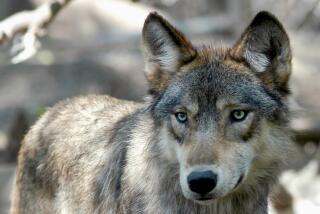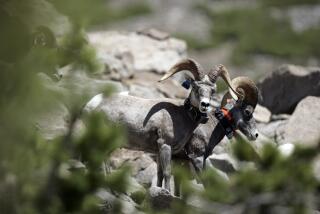Shepherds Thread Through Subdivisions on Way to Range
BOISE, Idaho — When he signed on to herd for one of Idaho’s oldest sheep companies, Percy Beruan did not know he would be moving them past Boise subdivisions.
“They like anything green,” he said. “They like to eat people’s grass and flowers.”
The band he tends, 2,400 sheep and lambs, is one of five owned by Highland Livestock of Emmett, Idaho. Company president Brad Little is the grandson of Andy Little, the legendary “Idaho Sheep King.”
Littles have trailed sheep through the Boise Front for most of this century, on what once was open range.
Today the historic trail is dotted with expensive new homes, a precarious blend of tradition and growth.
“People say they just want a place where they can be off by themselves, but the ink’s not dry on the deed and they’re pounding stakes for subdivisions,” Little said.
More than 10,000 of Little’s sheep and lambs will brush the city en route to their summer range. It is history repeating itself.
“The Highlands and Somerset Ridge all used to be sheep range,” Little said. “Where the Federal Building is now, they were lambing in April of 1936.”
Shepherds Vigilant
Most Boise residents will not know when the sheep pass by, and damage to suburban landscaping is expected to be minimal. That is due in part to the vigilance of the herders who keep the bands on the move.
They spend 10 months of the year moving sheep from low-country winter range to summer range in the mountains, and then back, working from sunup till sundown, living in cramped wagons far from home.
Beruan, like most sheepherders in contemporary Idaho, is from Peru. His family has sheep there, but he can make more money tending American sheep.
The salary is $650 a month, and the company pays his living expenses. His biggest out-of-pocket cost is for batteries for his shortwave radio.
“We have employees who make more than the sheepherders,” Little said, “but no one has as much take-home pay. I had one who, with the interest on his savings, took home more money than he made. They go home wealthy men.”
Loneliness and Boredom
But the trade-off is loneliness and boredom.
To pass the time, Beruan listens sparingly to his radio and studies English.
“And sometimes I read,” he said, whipping a Spanish-language edition of the Reader’s Digest from his parka pocket.
“I miss my family in Peru. And when I am too much time without seeing people, I miss people generally. Sometimes I go a month without seeing anyone.”
That does not include Julio Baldeon.
Baldeon, 26, tends the sheep camp and cooks the meals, often lamb from the flock, in a wagon just big enough for a stove, supplies and two bunks. The men were friends in their hometown of Junin, a Caldwell-size city in central Peru.
Under the terms of their contract, they can go home at company expense after working three years. Beruan, who is single, has grown accustomed to the long absences. Baldeon, who has a wife and baby daughter, has not.
A newcomer to Idaho, Baldeon is just breaking into the business. Beruan, who has been here four years, is a veteran.
He is 25 but looks older. Just over 5 feet tall, including his boots and the hood of his sweatshirt, he covers ground almost as fast as the border collies that help him tend the sheep.
“Look over there,” he said, pointing toward a distant hillside at sheep only he could see. “The sheep are going to that house. I have to hurry.”
He whistles softly, and the dogs fall in beside him. Then he strides away, climbing the steep slopes as if they were level ground, and heads off the sheep just before they reach a French chateau-style house being built in the lonely hills. He is not even slightly winded.
Trek to the Summer Range
Beruan and Baldeon begin the annual migration near Parma in February or March, after most of the lambs are born. They stay at each camp for one to three days, depending on the amount of grass and the regulations of the relevant jurisdictions, from counties to federal agencies.
They will reach their summer range in August. In October, they will turn around and come back.
Winters are spent on the ranch, helping with the lambing. Predators, usually coyotes, are a constant threat.
“The dogs chase most of the coyotes away,” Beruan said. “Sometimes, in the mountains, the bears attack in the night. In the mountains, I have a gun.”
Predator attacks provide rare excitement in a life many would find monotonous. One day is like another. Time is measured by the sun and the bleating of the sheep. When they stop bleating, it is time for dinner. When they start, at first light, it is time to get up. It is a life of watching, watching, watching.
Changing Character of the Range
Sheepherders have always watched for strays and predators, but today the job is bigger.
Jose Arrieta has worked for the Littles for 40 years. Now a foreman, he broke in as an 18-year-old from Spain when the Boise Front was mostly open space.
Now, he says, it is “people, houses, dogs, mountain bikers, Jeeps, motorcycles.”
A recent incident involving one of the company’s sheep dogs underscored the shrinking line between rural and urban. The dog, a puppy, followed a Boise hiker home from the hills. Arrieta subsequently was cited because it did not have a license.
“We were here first,” he said, “but sheep do not have much power anymore.”
In the 1930s, the heyday of Idaho’s sheep industry, Little’s grandfather owned more than 200,000 sheep. Today there are about that many in the entire state.
“We’re a shadow of what we used to be,” he said. “I hope we’ll still be around for my sons. They love the sheep business, but it’s getting to be more challenging all the time.”
More to Read
Sign up for Essential California
The most important California stories and recommendations in your inbox every morning.
You may occasionally receive promotional content from the Los Angeles Times.










